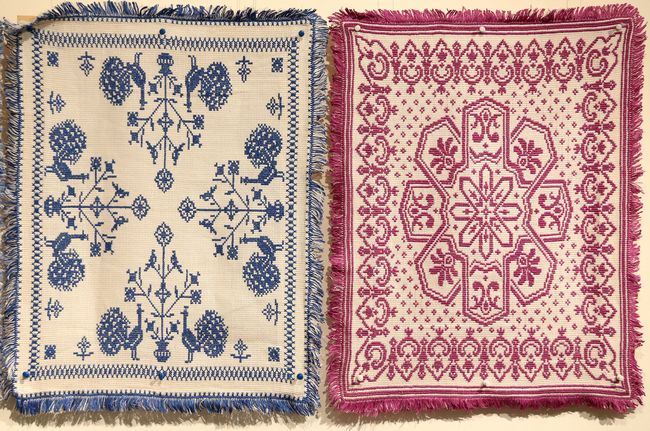The display features more than 200 works – copies of embroidery by Ukrainian female political prisoners, ornaments associated with prominent Ukrainians, embroidery from the Chornobyl exclusion zone. Almost all the artworks were created by Liudmyla Ohnieva, radio physicist by training, who has been making embroidery since 1996. The exhibition is called “The Cultural Space of Donetsk Region. Liudmyla Ohnieva: Ukrainian Embroidery.”
“I can’t live without embroidery. I make my art about what I want to tell the world. My embroidery is about that which has sense,” says Ohnieva. “It is difficult to estimate the time spent on every piece of embroidery. There is a towel – multicolored, with roses and ornaments characteristic of Donetsk – which had been in the making for five years.” By the way, the exhibition proves that Ukrainian embroidery has existed in Donbas for a long time. One of the arguments of that is a 19th-century towel from Makiivka, Donetsk oblast.

AN EMBROIDERY DEDICATED TO UKRAINIAN PILOT NADIA SAVCHENKO KIDNAPPED AND HELD IN A RUSSIAN PRETRIAL JAIL FOR MORE THAN A YEAR
The exhibition offers not only the unique embroidery, but also the information about outstanding figures of Ukrainian history. Red and black ornament with big rhombuses is dedicated to Andrii Avramenko (Iriy), Ukrainian actor and public figure, student of Les Kurbas. He had been arrested ten times from 1923 to 1944 for the participation in Ukrainian nationalist underground movement – both by the KGB and Gestapo. He was prohibited by Soviet authorities to live in large cities, so in 1930 he settled in Mariupol, Donetsk oblast. He worked in the theater, was one of the leaders of a local OUN(b) cell. His educational activities, Ukrainization efforts in the theater, and the OUN membership brought him the death sentence from the Soviet court in 1945.


Ohnieva moved from Donetsk in September past year. “I did not want to leave. A girl I knew brought me food and medicine. Every morning tanks from Makiivka used to ride past my house. A Grad missile launcher was stationed nearby. There was nowhere to escape or hide. I was sitting by the computer and working, I created layouts for embroidery and wrote something,” Ohnieva reminisces. “And one day the girl said that I should leave. She told me that elsewhere I would do more for the residents of Donbas than at home. This exhibition is the implementation of the will, which I received from the young people of Donetsk.”

THE TREE OF LIFE, AS SEEN IN ENGLAND
The embroidery of Liudmyla Ohnieva is on display at Ivan Honchar Museum through December 4.







